.
TOP 10 AT 10 KM
ESA’s comet-chasing Rosetta mission spent much of the second half of October orbiting Comet 67P/Churyumov–Gerasimenko at less than 10 km from its surface. This selection of previously unpublished ‘beauty shots’, taken by Rosetta’s navigation camera, presents the varied and dramatic terrain of this mysterious world from this close orbit phase of the mission.
Some light contrast enhancements have been made to emphasise certain features and to bring out features in the shadowed areas. In reality, the comet is extremely dark – blacker than coal. The images, taken in black-and-white, are grey-scaled according to the relative brightness of the features observed, which depends on local illumination conditions, surface characteristics and composition of the given area. Some slight vignetting can also be seen in the corners of some images.
.
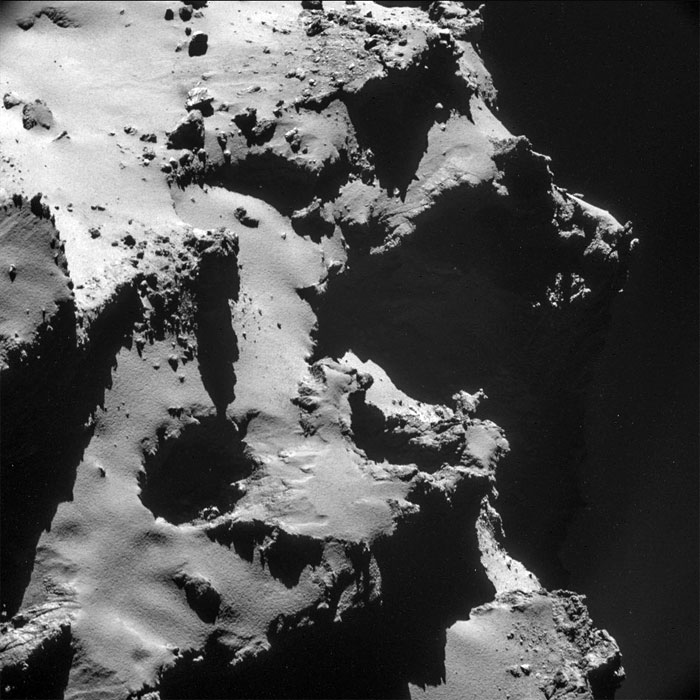
.
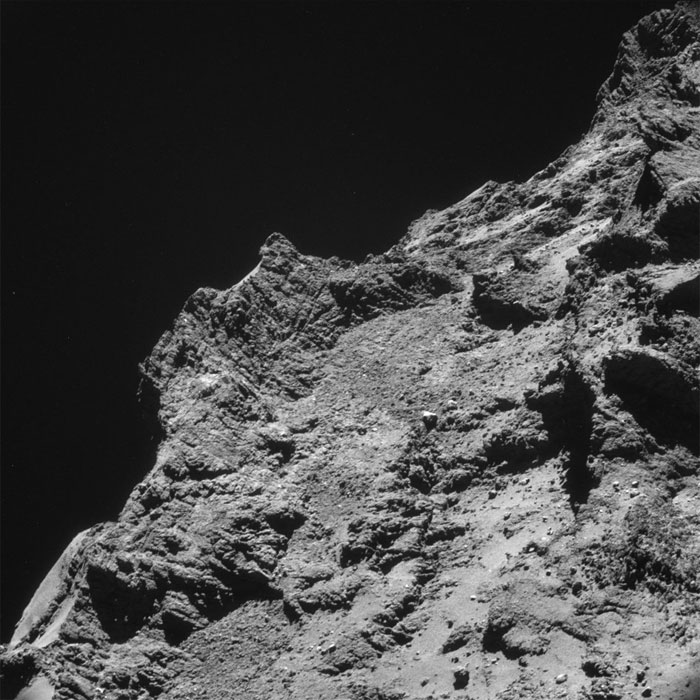
ESA’s comet-chasing Rosetta mission spent much of the second half of October orbiting Comet 67P/Churyumov–Gerasimenko at less than 10 km from its surface. This selection of previously unpublished ‘beauty shots’, taken by Rosetta’s navigation camera, presents the varied and dramatic terrain of this mysterious world from this close orbit phase of the mission.
Some light contrast enhancements have been made to emphasise certain features and to bring out features in the shadowed areas. In reality, the comet is extremely dark – blacker than coal. The images, taken in black-and-white, are grey-scaled according to the relative brightness of the features observed, which depends on local illumination conditions, surface characteristics and composition of the given area. Some slight vignetting can also be seen in the corners of some images.
.
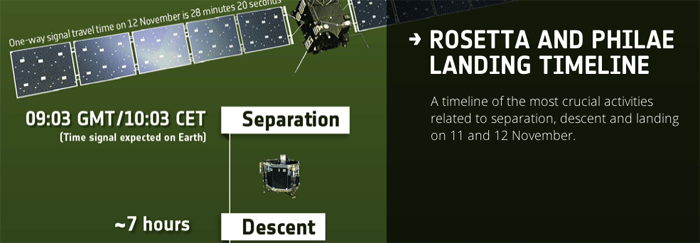
ROSETTA AND PHILAE LANDING TIMELINE
A timeline of the most crucial activities related to separation, descent and landing on 11 and 12 November.
It has been compiled with inputs from the Flight Control Team at ESOC and the Science Operations Team at ESAC and is accurate as of now. PLEASE remember: many of these times are subject to change and confirmation, given the extremely dynamic nature of this delicate and complex operation. We'll do our best to update this as we receive firm information, but on 12 November the live webcasts from ESA TV and ESA's social media accounts (Twitter!) will be the best ways to get the latest information.
Admittedly, this timeline is a little dense, but we thought it better to provide more detail for those who – like us! – are extreme Rosetta & Philae fans (and you know who you are!). We'll publish a lighter version in the main ESA website later today and there's also a high-level version in the press kit (PDF; page 63 or in SlideShare here). And for those who wish, here is the opposite: an even more detailed version as a PDF, or also in Slideshare.
.
Date
UTC
on Earth
CET
on Earth
Event
11/11 01:48:49 02:48:49 BOT ESA New Norcia (NNO)
11/11 03:10:00 04:10:00 BOT NASA DSN Canberra
11/11 12:25:00 13:25:00 EOT Canberra
11/11 13:40:00 14:40:00 BOT DSN Madrid
11/11 13:58:05 14:58:05 BOT ESA Malargüe (MLG)
11/11 14:00:00 15:00:00 Flight Dynamics Team at ESOC begin orbit determination procedure to accurately fix Rosetta's precise trajectory
11/11 14:30:17 15:30:17 EOT ESA NNO
11/11 18:33:20 19:33:20 Lander switch-on. Includes switching on Electrical Support System, which controls orbiter communication interface with the lander
11/11 19:05:20 20:05:20 Lander batteries and compartment heating
ADS Tank (Active Descent System - provides cold gas thrust upwards to avoid rebound upon landing) opening
11/11 19:25:20 20:25:20 Lander Primary Battery conditioning start; about 28 mins
11/11 19:00:00 20:00:00 EOT DSN Madrid
11/11 19:30:00 20:30:00 GO/NOGO1 - Last full orbit determination; ESOC Flight Dynamics confirms Rosetta trajectory is correct
11/11 20:03:00 21:03:00 Rosetta starts slew to pre-delivery manoeuvre attitude (expected loss of signal)
11/11 20:20:00 21:20:00 BOT DSN Goldstone
11/11 20:43:00 21:43:00 End of Rosetta slew
11/11 20:52:20 21:52:20 Start Lander flywheel operation - provides stability during descent
11/11 23:25:00 00:25:00 BOT DSN Goldstone
11/11 23:40:00 00:40:00 BOT DSN Canberra
12/11 00:00:00 01:00:00 EOT DSN Goldstone
12/11 00:00:00 01:00:00 GO/NOGO 2(a) - Confirm telecommands to control delivery sequence are ready
GO/NOGO 2(b) - ESOC confirms Rosetta is ready
12/11 01:00:00 02:00:00 ESOC uploads commands to control spacecraft for Lander delivery operations
12/11 01:03:20 02:03:20 Lander generates final telemetry (TM) on-board prior to GO/NOGO for SEP decision
12/11 01:35:00 02:35:00 GO/NOGO 3 - Confirm Philae is ready for landing
12/11 01:46:10 02:46:10 BOT ESA New Norcia
12/11 03:02:50 04:02:50 EOT ESA Malargüe
12/11 04:03:20 05:03:20 Lander - start of Separation, Descent & Landing (SDL) activities
Start switching Lander instruments ON; ROMAP first
12/11 04:28:20 05:28:20 Rosetta - Start executing on-board commands for delivery operations
12/11 04:34:20 05:34:20 Start heating Lander batteries to separation temperature
12/11 06:03:20 07:03:20 Rosetta - Earliest start pre-delivery manoeuvre (thruster burn)
Burn will be followed by loss of signal due to subsequent slew for separation
Manoeuvre expected to be about 0.46m/s & about 6 mins duration
Date
UTC
on Earth
CET
on Earth
Event
12/11 06:35:00 07:35:00 Earliest GO/NOGO 4 - final decision to go for landing
12/11 07:03:20 08:03:20 Rosetta - Latest start pre-delivery manoeuvre
12/11 07:35:00 08:35:00 Latest GO/NOGO 4 - final decision to go for landing
- - Following MVR, ESOC Flight Dynamics Team conducts rapid assessment of MVR performance to verify burn results
12/11 07:49:20 08:49:20 Lander - Switch on MUPUS
12/11 07:52:20 08:52:20 Start MUPUS operation and switch-on CivaRolis
ÇIVA and ROLIS are imaging systems; ÇIVA makes panoramic images, ROLIS looks down
12/11 07:55:20 08:55:20 Start CivaRolis operation and switch-on SESAME (dust sensor)
12/11 08:04:20 09:04:20 Start SESAME operation
12/11 08:46:20 09:46:20 Start MSS (Mechanical Support System), which executes the mechanical separation from the Orbiter
12/11 08:46:20 09:46:20 Separation Motors ON
12/11 08:49:20 09:49:20 Start CONSERT Orbiter operation
12/11 08:50:20 09:50:20 Start CONSERT Lander operation
12/11 08:51:20 09:51:20 Start MSS sequence - internal autosequence to prepare for landing
12/11 08:53:20 09:53:20 Lander now on internal battery power
12/11 - - Screws in Separation Motors start to rotate and impart deployment speed to push Lander away, retrograde .21 m/s
12/11 09:03:20 10:03:20 PHILAE SEPARATION (Forecast; 94-sec window)
Separation confirmation received on ground via ESA's NNO New Norcia station
12/11 09:04:12 10:04:12 Lander (ÇIVA) obtains first images of Orbiter (FAREWELL1)
12/11 09:06:17 10:06:17 Lander (ÇIVA) obtains seconds images of Orbiter (FAREWELL2)
12/11 09:12:17 10:12:17 Lander / Orbiter separation distance now ~100m
Earliest autodeployment of landing gear and ROMAP boom antenna
12/11 09:25:50 10:25:50 Lander starts rotation of 14 degrees to stable landing orientation
12/11 09:43:20 10:43:20 Rosetta performs post-delivery manoeuvre
Burn will be followed by loss of signal due to subsequent slew back to nominal pointing
Manoeuvre magnitude to be determined on 12/11
12/11 09:47:17 10:47:17 Lander completes all post-separation activities
12/11 10:53:20 11:53:20 Acquisition of signal (AOS) from Rosetta
Expected AOS; link with Rosetta now re-established
12/11 11:59:20 12:59:20 Start of stored data downlink from Rosetta & Philae
12/11 12:20:00 13:20:00 EOT DSN Canberra
12/11 13:15:00 14:15:00 BOT DSN Madrid
12/11 13:55:00 14:55:00 BOT ESA MLG
12/11 14:27:00 15:27:00 EOT NNO
12/11 14:58:57 15:58:57 Lander - switch-on Anchor & CivaRolis
Date
UTC
on Earth
CET
on Earth
Event
12/11 15:01:57 16:01:57 Lander - start imaging landing site and switch on ADS (Active Descent System)
12/11 15:07:02 16:07:02 ROLIS begins imaging
12/11 15:17:15 16:17:15 On board Lander, systems conduct final pre-touch-down operations
12/11 15:22:20 16:22:20 Start of Lander touch-down window
12/11 16:02:20 17:02:20 EXPECTED LANDING and receipt of signal (Forecast; 40 min variability)
12/11 - - Upon landing - start post-touch-down operations including:
* ADS thruster fires for ~15 sec to avoid rebound
* Harpoons (X2) fire to secure Lander to surface
* Flywheel off
12/11 16:07:12 17:07:12 ÇIVA-P panoramic imaging on
Lander obtains first images of surface and transmits same (forecast; depends on landing time)
12/11 16:07:14 17:07:14 Separation, Descent & Landing (SDL) science observations continue: Ptolemy & COSAC begin science gathering; data collected during descent and initial surface observations will be uploaded
12/11 16:39:39 17:39:39 Lander completes SDL operations; upload of science data
12/11 17:49:07 18:49:07 Lander begins First Science Sequence (FSS) Block 1; runs about 7 hours
12/11 19:00:00 20:00:00 EOT DSN Madrid
12/11 19:03:00 20:03:00 End of Lander/Orbiter first communication window
13/11 01:43:00 02:43:00 BOT ESA NNO
13/11 02:59:00 03:59:00 EOT ESA MLG
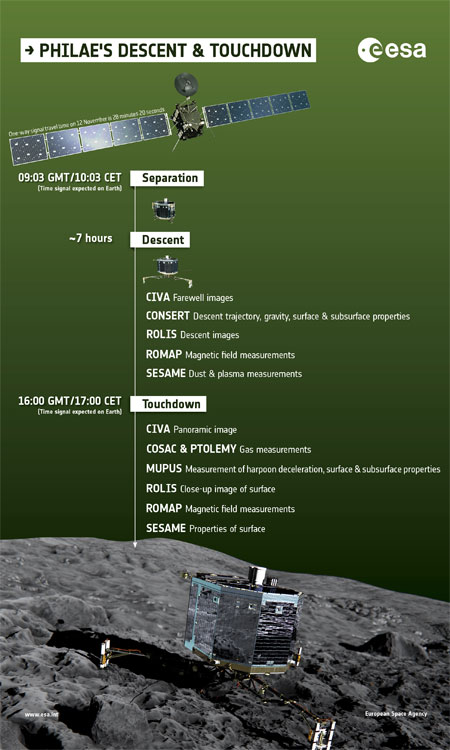
Quelle: ESA
.
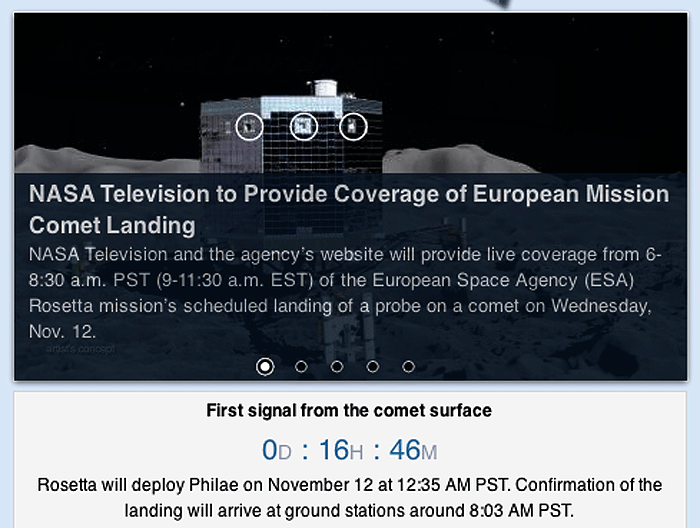
Quelle: NASA
.
Update: 23.00 MEZ
.
TRACKING PHILAE’S DESCENT WITH MAGNETIC DATA
ROMAP co-principal investigator Hans-Ulrich Auster from the Technische Universität Braunschweig, Germany, explains how the instrument will be used with RPC (on the Rosetta orbiter) to monitor Philae as it descends to the surface of comet 67P/Churyumov-Gerasimenko on 12 November – as well as looking out for any evidence of a ‘fossil’ magnetic field linked to the comet itself.
On 12 November, the magnetic field instruments on-board the Rosetta orbiter and lander will be assigned the task of monitoring Philae as it descends to the surface.
That’s possible because both the lander and the orbiter generate small magnetic fields of their own, due to the electronic circuits inside the spacecraft. These magnetic fields create perturbations in the data that the scientists normally remove in order to analyse the purely natural magnetic fields from the comet and the solar wind. However, on 12 November, these perturbations can be analysed to tell what is happening to the lander as it slowly drops towards the surface of 67P/C-G.
Once the lander has separated, the magnetic perturbation registered near the orbiter will decrease as Philae moves away. Later, when the lander deploys a boom arm for its ROMAP instrument, it will cause a brief variation in the perturbation. A similar variation may also be registered when the three landing legs spring into place.
The perturbations may prove too subtle for the RPC instruments, operating on Rosetta at some distance from Philae, but the ROMAP instrument on the lander will register the changes loud and clear.
“We will be able tell what is happening on the lander by the changes in its magnetic field,” says ROMAP co-principal investigator Hans-Ulrich Auster.
These measurements will add to the overall picture of Philae’s progress to the surface of the comet.
Of course, the main focus of these instruments is on science. The comet should retain a memory of any magnetic field that was present in its environs 4.6 billion years ago when the Earth and the other planets were forming. For example, some theories of star and planet formation require a magnetic field to accelerate the growth of our Solar System, while others do not, and thus by measuring the ‘fossil’ field, Rosetta can hope to shed light on this epoch.
In the final few hundred metres of Philae’s descent, ROMAP will detect this magnetic fossil if it exists.
“It’s a simple question, is it there: yes or no. We are just a few days away from knowing the answer to this,” says Auster.
After the landing, ROMAP will again play an operational role, by helping scientists determine the angle at which the lander has come to rest. This will be essential to help orient the lander so that as much light as possible falls onto its solar panels.
Although there are other ways in which this information will be monitored and returned to Earth, the contribution from RPC and ROMAP should prove very valuable.
“We will do everything we can to help understand the overall state of Philae after landing,” says RPC principal investigator Karl-Heinz Glaßmeier, also from the Technische Universität Braunschweig, Germany.
“After all, the more that can be done to keep the lander functioning, the more science will flow from the mission. And the more we will learn of our cosmic origins.”
.
STATUS UPDATE – 11 NOVEMBER
It was a busy night for the Rosetta and Philae operations team, reported Rosetta flight director Andrea Accomazzo during this morning’s press briefing at ESA's spacecraft operations centre (ESOC), who delivered the news that the lander Philae did not switch on correctly at first. But, after a reboot, the lander successfully powered up, and preparations are now continuing as planned.
Andrea also reported that the flight dynamics for the Rosetta orbiter looks good, and that the final orbit determination will be made this afternoon.
“We’re ready for tonight with no concerns,” he said.
Tonight sees the start of a series of critical Go/NoGo decisions that must be made before separation can occur (see http://blogs.esa.int/rosetta/2014/11/07/landing-operations-the-most-critical-moments-you-should-watch-for/ for a summary of these milestones).
We’ll report the outcomes in blog posts and on our social media channels, and you can also follow live from 19:00 GMT/20:00 CET via esa.int/rosetta.
.
THE SINGING COMET
Rosetta’s Plasma Consortium (RPC) has uncovered a mysterious ‘song’ that Comet 67P/Churyumov-Gerasimenko is singing into space. RPC principal investigator Karl-Heinz Glaßmeier, head of Space Physics and Space Sensorics at the Technische Universität Braunschweig, Germany, tells us more.
.

RPC consists of five instruments on the Rosetta orbiter that provide a wide variety of complementary information about the plasma environment surrounding Comet 67P/C-G. (Reminder: Plasma is the fourth state of matter, an electrically conductive gas that can carry magnetic fields and electrical currents.)
The instruments are designed to study a number of phenomena, including: the interaction of 67P/C-G with the solar wind, a continuous stream of plasma emitted by the Sun; changes of activity on the comet; the structure and dynamics of the comet’s tenuous plasma ‘atmosphere’, known as the coma; and the physical properties of the cometary nucleus and surface.
But one observation has taken the RPC scientists somewhat by surprise. The comet seems to be emitting a ‘song’ in the form of oscillations in the magnetic field in the comet’s environment. It is being sung at 40-50 millihertz, far below human hearing, which typically picks up sound between 20 Hz and 20 kHz. To make the music audible to the human ear, the frequencies have been increased by a factor of about 10,000.
The music was heard clearly by the magnetometer experiment (RPC-Mag) for the first time in August, when Rosetta drew to within 100 km of 67P/C-G. The scientists think it must be produced in some way by the activity of the comet, as it releases neutral particles into space where they become electrically charged due to a process called ionisation. But the precise physical mechanism behind the oscillations remains a mystery.
“This is exciting because it is completely new to us. We did not expect this and we are still working to understand the physics of what is happening,” says Karl-Heinz.
RPC may also be able to help in tracking Philae’s descent to the surface of 67P/C-G on 12 November, in tandem with the lander’s on-board magnetometer, ROMAP .

The contributing institutions to these instruments are:
RPC: Institutet för rymdfysik (IRF), Uppsala, Sweden; Southwest Research Institute (SwRI), USA; Institut für Geophysik und Extraterrestrische Physik, Technische Universität Braunschweig, Germany; Laboratoire de physique et chimie de l'environnement et de l'espace (LPC2E), Université d'Orléans, France, and Imperial College London, United Kingdom.
RPC-Mag: Institut für Geophysik und Extraterrestrische Physik, Technische Universität Braunschweig, Germany; Imperial College London, United Kingdom; Space Research Institute Graz, Austria
.
SCIENCE UPDATE – 11 NOVEMBER: THREE MONTHS AT THE COMET
During this morning's media briefing at the European Space Operations Centre (ESOC) in Darmstadt, Germany, there was also an overview of the scientific activities conducted at Comet 67P/C-G so far, presented by Matt Taylor, ESA Rosetta project scientist.
Regular readers of this blog are surely familiar with the progress achieved by Rosetta in the past few months, but for those who are relatively new to the mission, we will summarise Matt Taylor's talk and present the highlights from the science operations so far.
Rosetta started scientific operations on 7 May 2014, while still at a distance of almost two million km from the comet. At the time, the comet covered less than one pixel on the sensors of the cameras on Rosetta, but as the spacecraft approached its target, scientists started to realise that the shape of the comet was quite different than what had been assumed on the basis of observations from telescopes on the ground and orbiting around Earth.
.
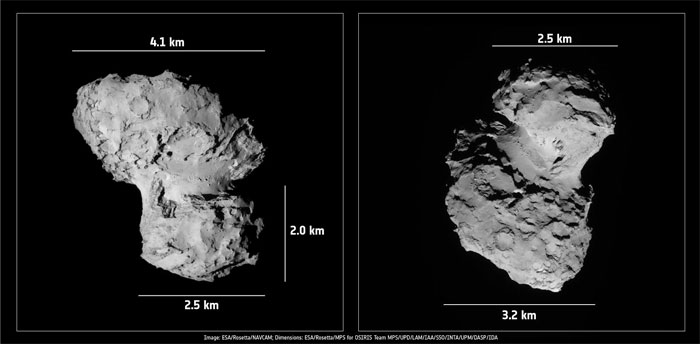
Comet 67P/C-G dimensions. Images: NAVCAM; dimensions: OSIRIS
.
We are now all well familiar with Comet 67P/C-G's curious shape with a smaller and larger lobe - which scientists now almost customarily call the 'head' and 'body', connected by the 'neck'.
Rosetta closed in on its target on 6 August, at a distance of about 100 km, and has been conducting a series of manoeuvres ever since, getting down to distances of less than 10 km from the comet's centre. Over the past three months, scientists from the OSIRIS team have been studying the comet and its surface in great detail to enable the selection of a landing site for Philae and the landing itself.
Meanwhile, other instruments on Rosetta have been studying the comet under different 'angles', from the global properties of the coma to the very local properties of dust grains. Using VIRTIS observations in infrared, scientists have measured the temperature at the surface of the comet, which is warmer than expected, revealing that the surface is made of dusty, porous material.
Ever since ancient history, comets have fascinated humans because of their unpredictability. And even now, when we know the behaviour of many comets so well to send a mission to orbit one, comets are still exciting because they do things that we don't expect. One such surprise was an outburst of the comet's activity seen in March/April, although at the time Rosetta was still too distant to figure out what was causing the increase in activity.
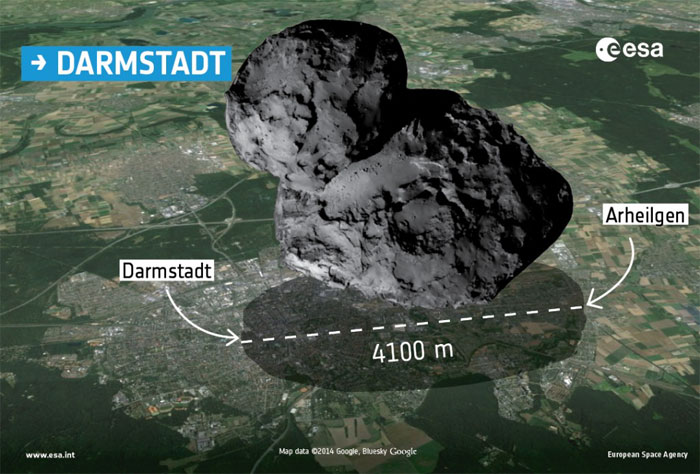
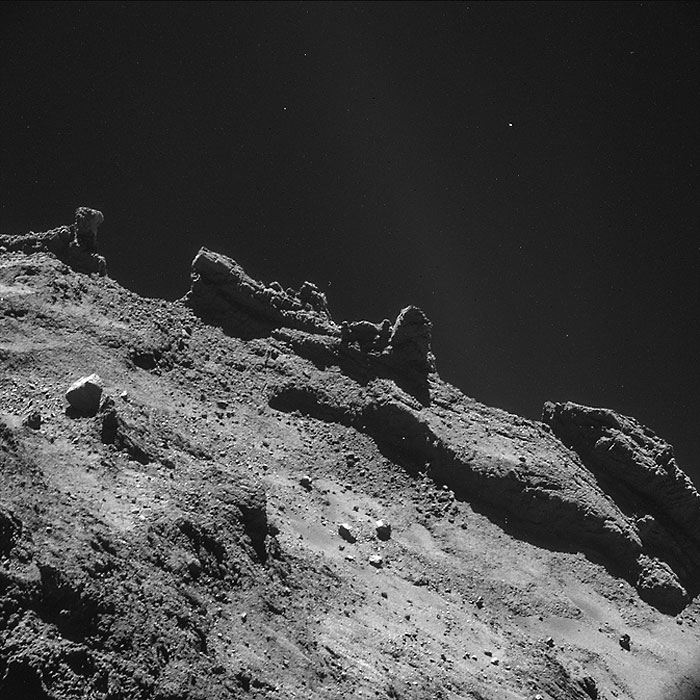
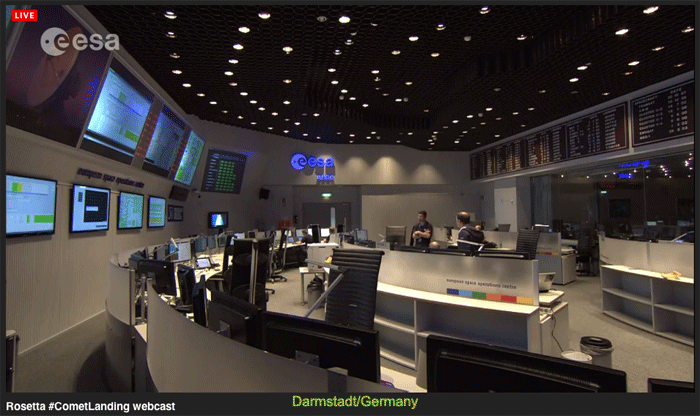
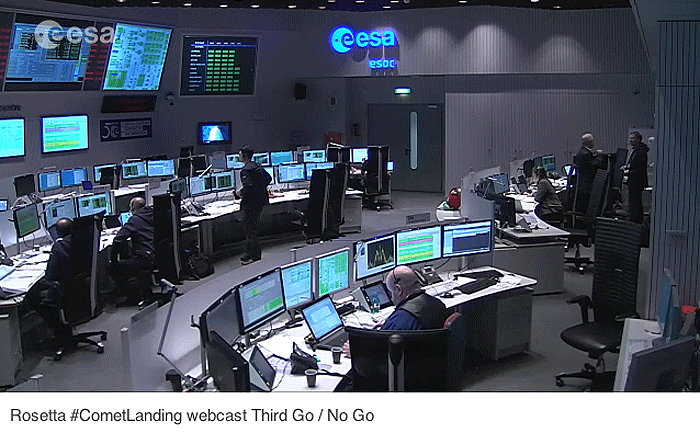
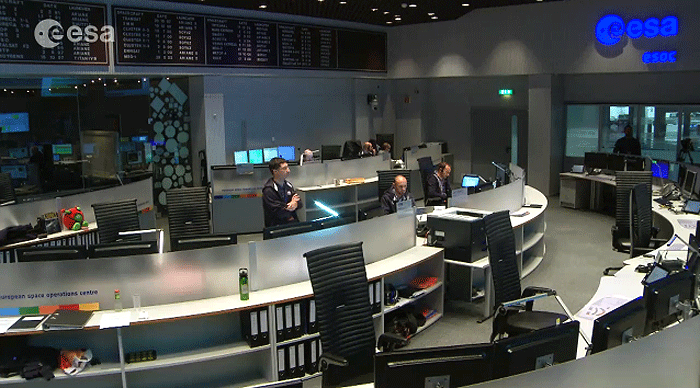
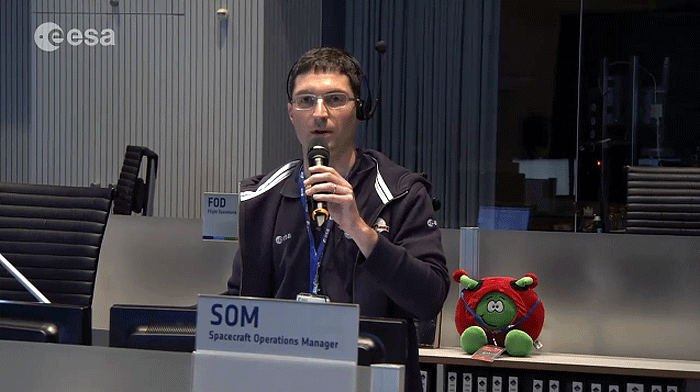
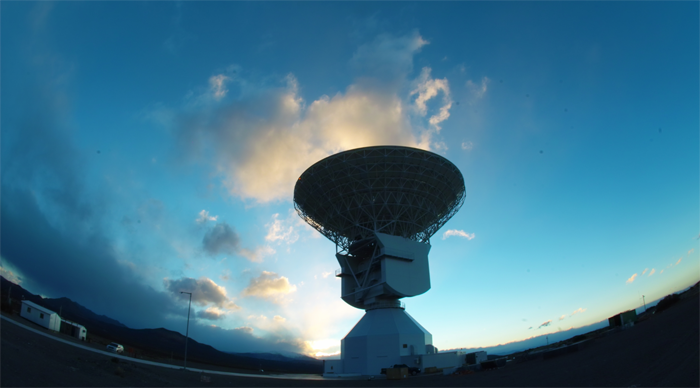

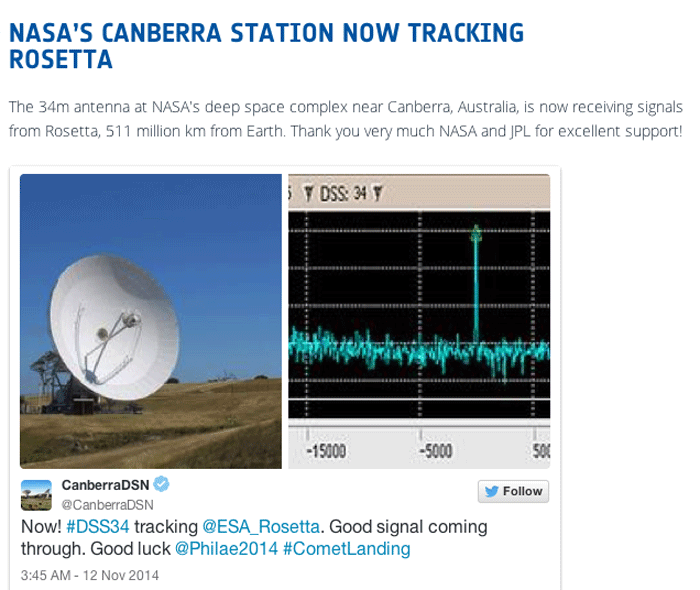
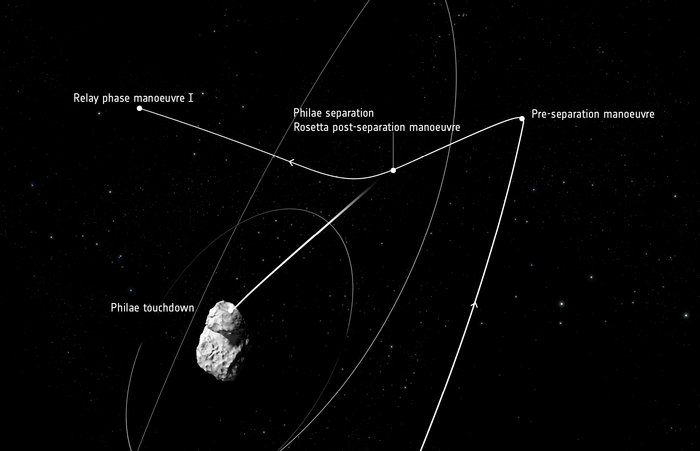
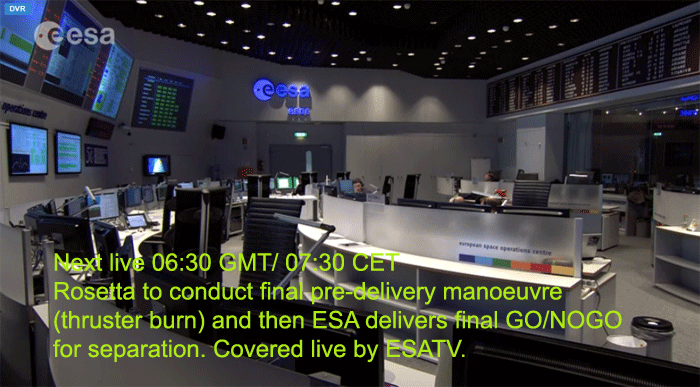
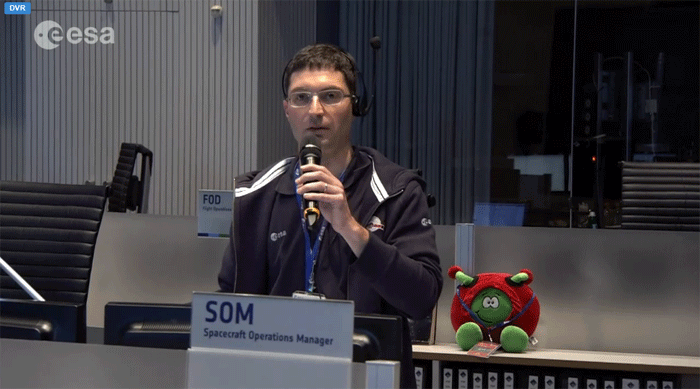
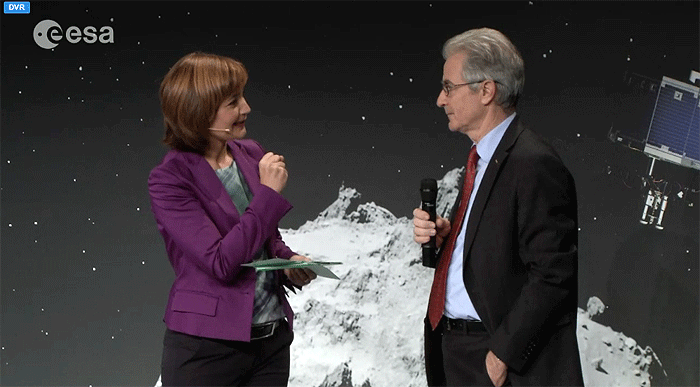
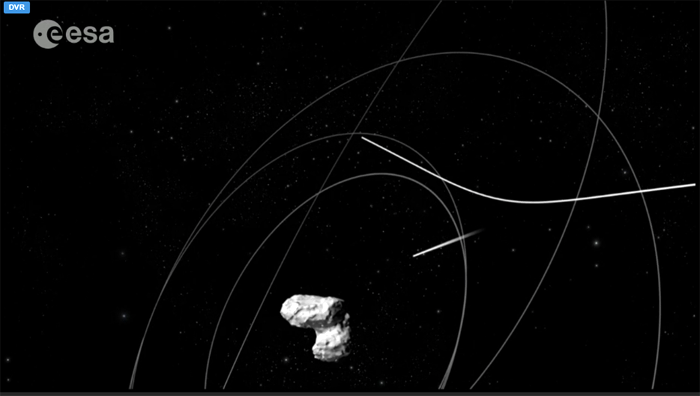
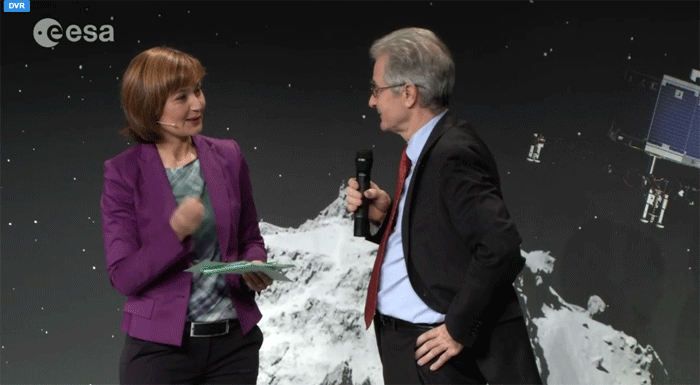
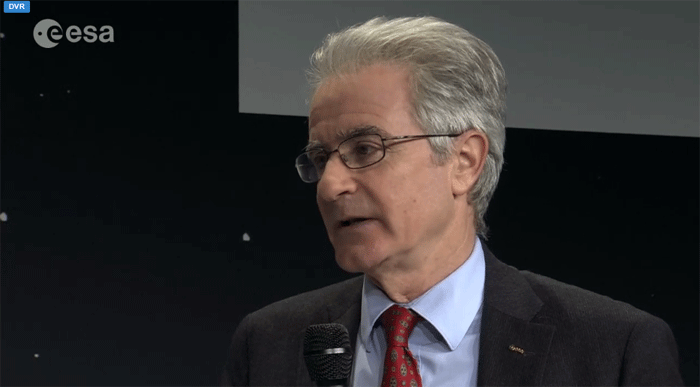
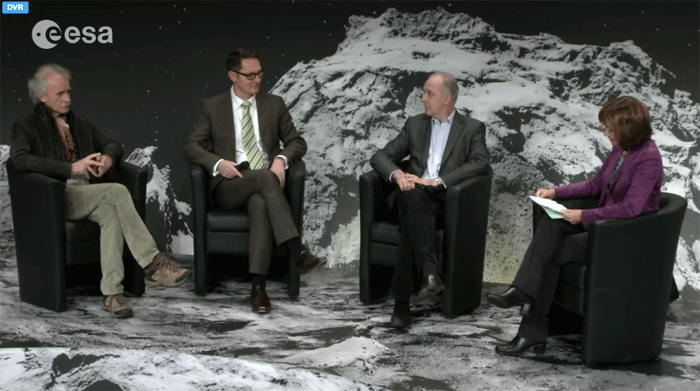
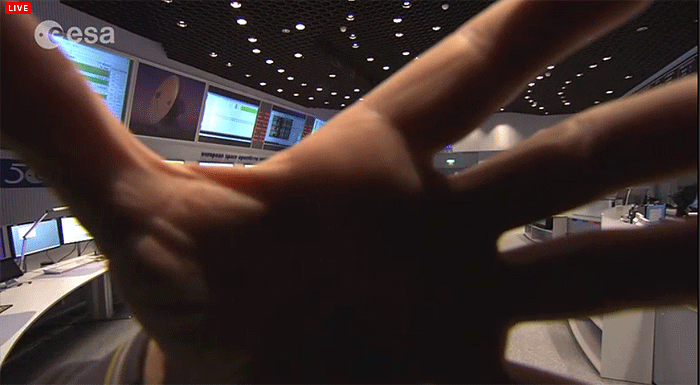

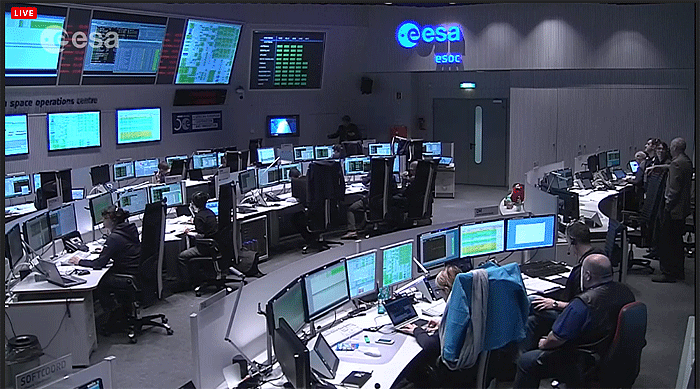
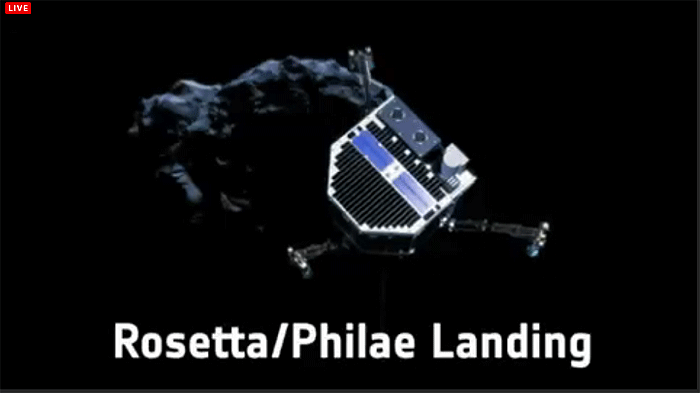
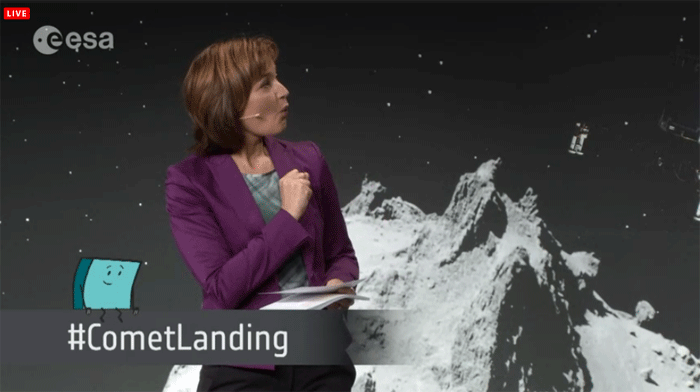
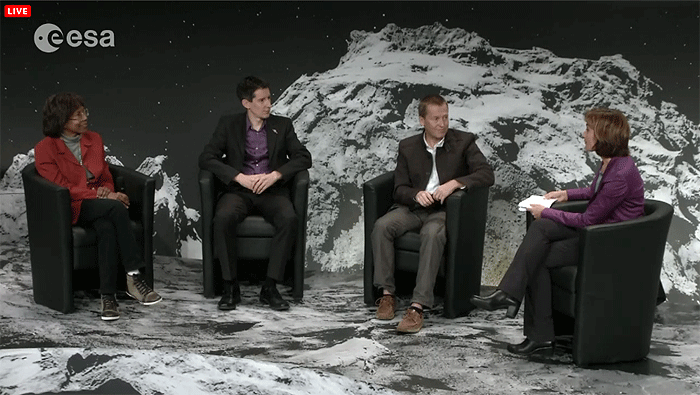
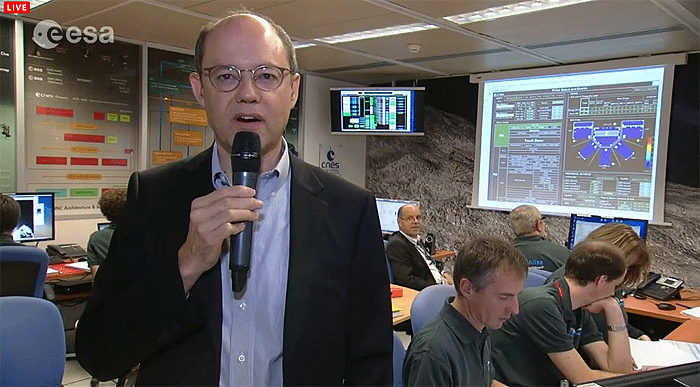

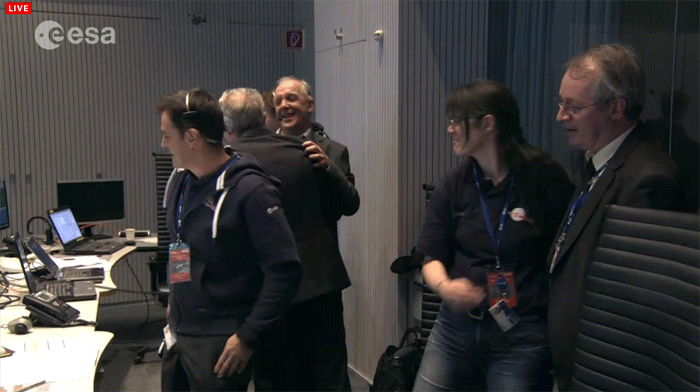
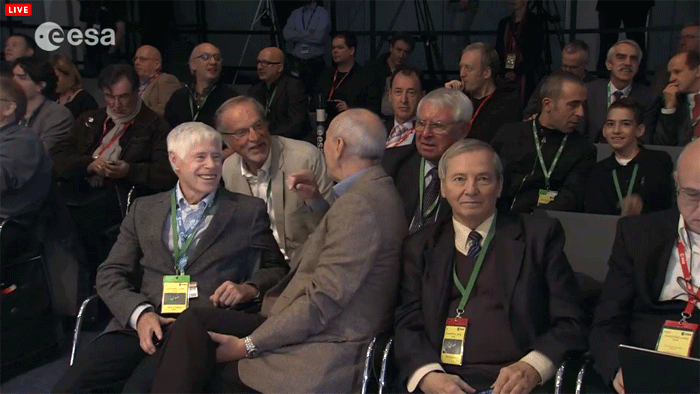
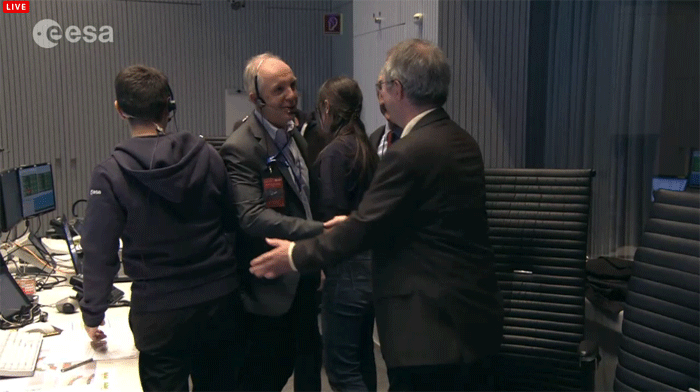
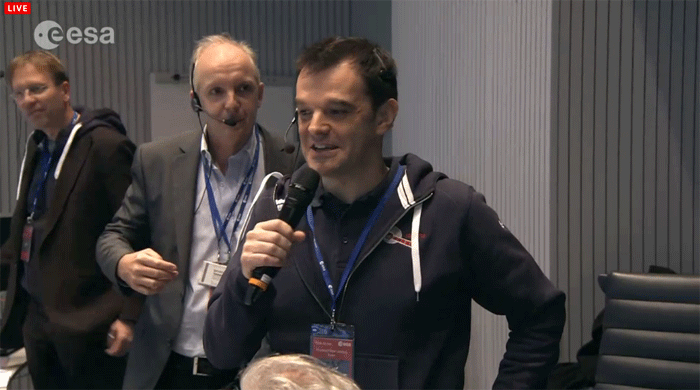
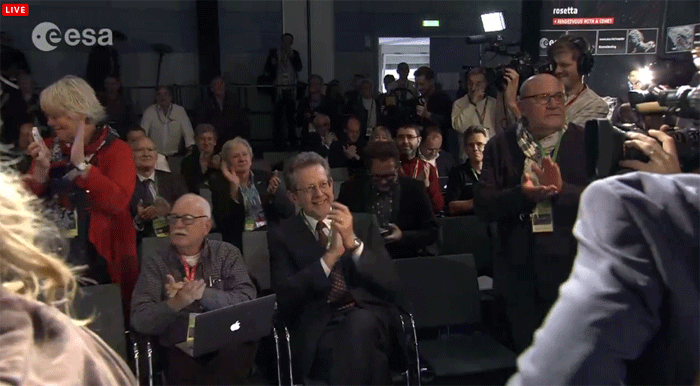
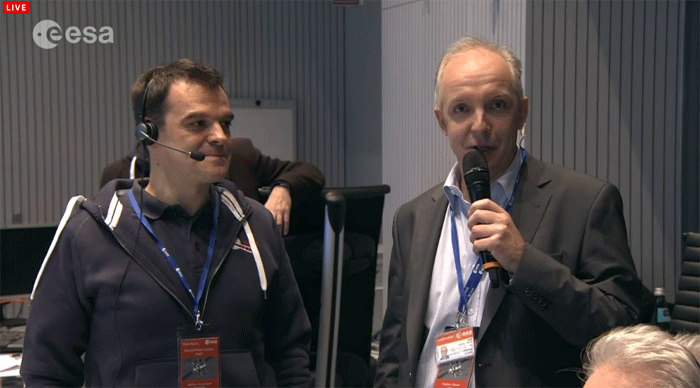
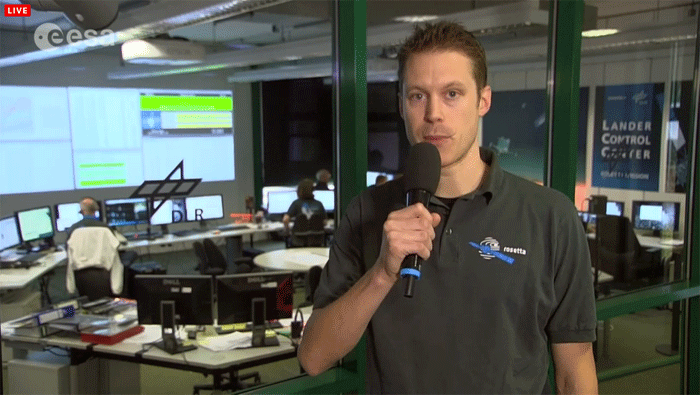
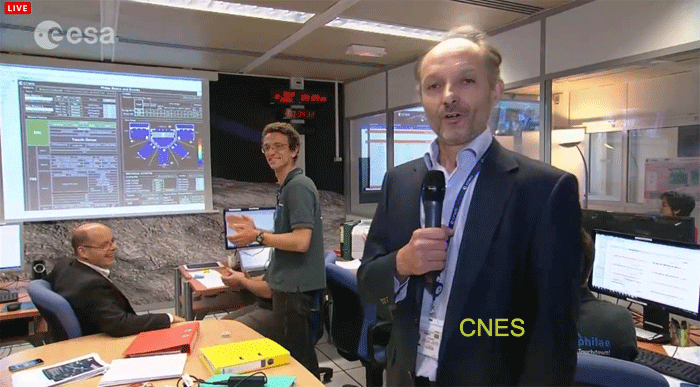
The MIRO instrument on Rosetta started detecting water outgassing from the comet in June. At the time, Rosetta was 350,000 km away from the comet - roughly the distance between Earth and the Moon - and MIRO saw 67P/C-G 'sweat' about 300 ml of water per second - the equivalent of two glasses. The activity has increased ever since, with peaks of 5 liters of water per second seen by MIRO recently.
ROSINA, the 'comet sniffer' on Rosetta, has detected a variety of molecules in the coma of 67P/C-G, including water, carbon monoxide, carbon dioxide, methane, and a few nitrogen or sulphur species. Recently, also VIRTIS detected both water and carbon dioxide in the comet's coma, measuring their relative abundance.
As for the dust, the GIADA instrument on Rosetta has been measuring dust particles and their velocities, while COSIMA has caught a handful of dust grains and has been analysing them, revealing that at leas one of them – the famous 'Boris' dust grain – contains sodium and magnesium.
Another way to study the comet's activity is by observing the ionised gas, or plasma, in the comet's environment and how it interacts with the solar wind, as the stream of electrically charged particles released by the Sun is perturbed by the presence of the comet. This is performed by Rosetta’s Plasma Consortium (RPC), a set of five instruments on Rosetta, which recently detected interesting oscillations in the magnetic field in the comet’s environment.
In addition to all the measurements performed by Rosetta is at 67P/C-G, astronomers are using telescopes on the ground to observe the comet's environment and its 19,000-km-long coma, exploiting this unique opportunity to monitor the comet while Rosetta is there and collecting data. They will continue to do so throughout the next year leading to perihelion in August 2015.
You can also watch a short movie showing the highlights of Rosetta so far, through the voices of some of the many people involved in the mission.
.
COMET OVER CITIES IN EUROPE
With less than one day until Rosetta deploys Philae on Comet 67P/Churyumov-Gerasimenko, here is a set of images to compare the size of the comet with a few cities across Europe.
Let's start with Darmstadt, Germany, home to ESA's European Space Operations Centre (ESOC) where the international media event following the comet landing is taking place this week.
.

Comet 67P/C-G over Darmstadt, Germany. Credit: ESA/Rosetta/Navcam; Map data ©2014 Google, Bluesky
.

A jagged horizon of the nucleus of comet 67P/Churyumov-Gerasimenko appears in this image taken by the navigation camera on the European Space Agency's Rosetta spacecraft during the second half of October 2014. The image was taken from a distance of less than 6 miles (10 kilometers) from the surface.
Image Credit: ESA/Rosetta/NAVCAM

Quelle: ESA
.
Update: 12.11.2014
.



...
ESA ROLLS OUT THE BIG IRON
If you've been following the Rosetta and Philae mission to comet 67P/C-G, you'll know that the crucial link between the mission controllers on Earth and the two craft voyaging hundreds of millions of kilometres deep in space are the ground tracking stations.

One of the world’s most sophisticated satellite tracking stations was inaugurated in Malargüe, Argentina, 1000 km west of Buenos Aires, in December 2012. Credit: ESA
For landing operations this week, ESA is once again rolling out the 'big iron' - two of the Agency's three ultra-sensitive 35m deep-space tracking stations, these ones located at Malargüe, Argentina, and New Norcia, Australia.
The two stations will be sharing communication duties in alteration, with typical 'passes' -- the time slots when Rosetta is actually in visibility -- lasting about 10 to 13 hours.
On 11 November, Malargüe station started its afternoon pass at 14:58 CET, and remained on duty until about 04:00 CET today. In this time slot, Malargüe was used by the mission team at ESOC to upload the commands that will control Rosetta during lander delivery operations (set to take place about 02:00 CET Wednesday). It also received the final telemetry -- housekeeping and status data -- generated from the lander prior to the GO/NOGO for separation decision.
Next, New Norcia began its track starting at 02:46 CET (there's a bit of overlap between one station finishing its track and the other starting) and it will remain in contact most of the day on 12 November. It will receive the crucial AOS -- acquisition of signal -- from the lander about two hours after separation, around 11:53 CET; this will be relayed from the lander via Rosetta (Philae can't communicate to Earth directly).
Malargüe will then receive the signals that confirm touch down, set for about 17:00 CET.
But it isn't only ESA that is rolling out the 'big iron' to support the landing.
Due to the very tight timeline and the need for the mission teams to receive telemetry signals from the spacecraft at all times and also be able to support back-up uplink in case it’s required, ESA have asked NASA to provide critical back-up support.
NASA stations at Canberra, Australia, Goldstone, California and Madrid, Spain, will conduct 'shadow tracking' in which they will remain locked on Rosetta TM signal at all times. This will enable an extremely quick switchover from the nominal ESA station, in the event of any technical problem at New Norcia or Malargüe, to the back-up NASA station. It also helps ensure that not a single bit of precious telemetry or science data are lost.
The full list of ESA and NASA stations is given in the PDF timeline. As can be seen by the blue green and yellow columns, there are no critical slots when an ESA station isn't fully shadowed by a NASA station.
...

...

...

...

... 7.45 MEZ
Last night’s 3rd Go/NoGo delayed due to problem with lander cold gas system but everything else is nominal. More to follow. #cometlanding
Retweeted by ESA Rosetta Mission
...
...8.00 MEZ






...
... 9.20 MEZ

Greifen wir uns den Kometen...


...
... 10.20 MEZ

Erfolgreiche Trennung von Philae von Rosetta / Philae auf Kometen-Kurs




...Klick








...
5265 Views
